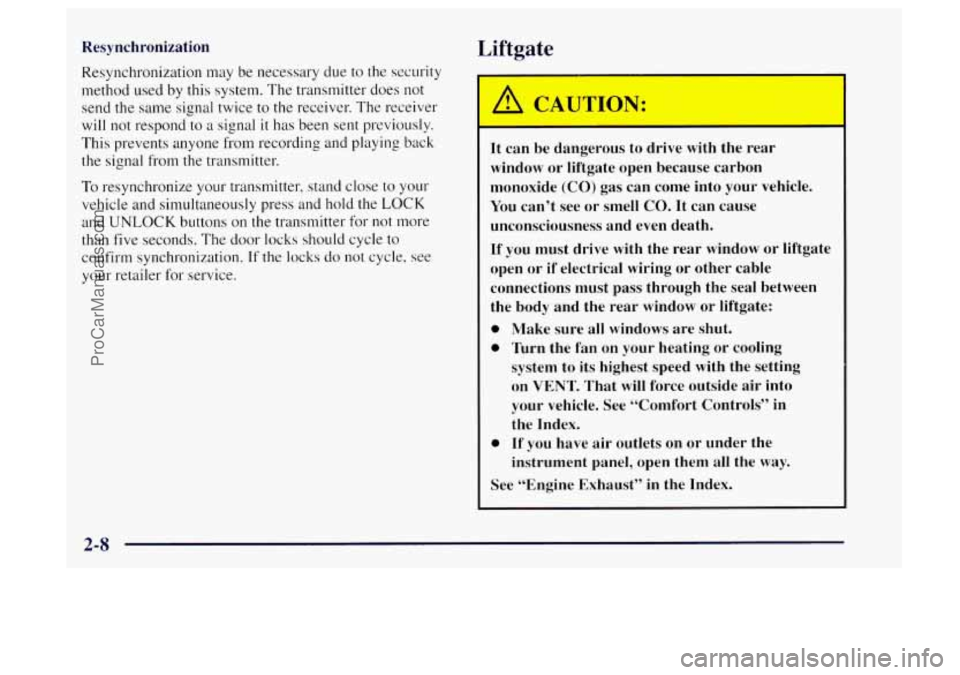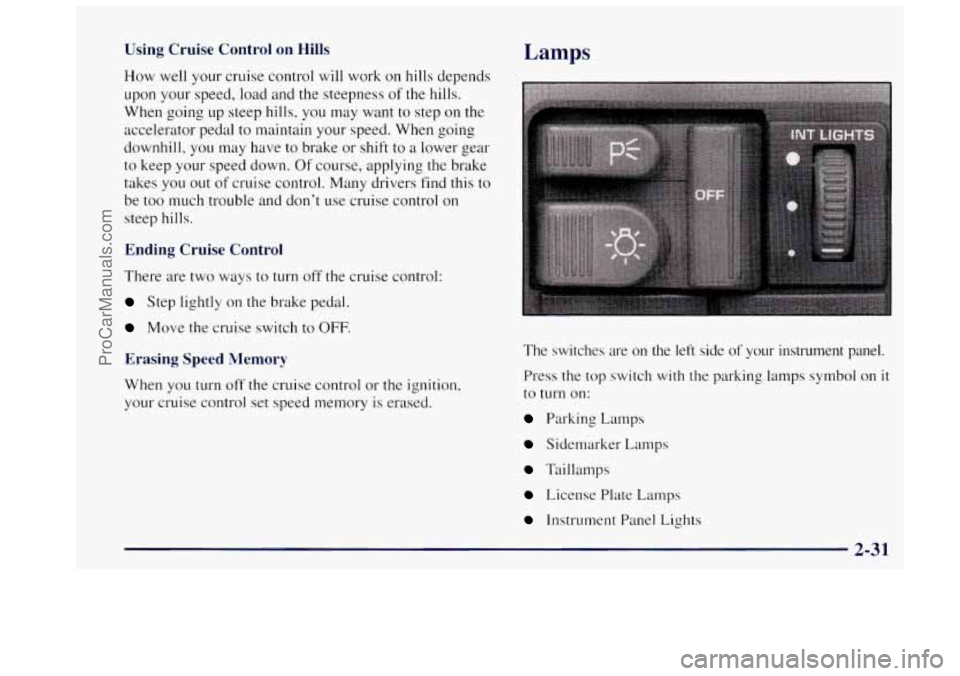Page 17 of 358
The person keeps going until stopped by something.
In
a real vehicle, it could be the windshield ...
or the instrument panel ...
1-9
ProCarManuals.com
Page 27 of 358
designed to work only in moderate to severe
crashes where the front of your vehicle hits
something. They aren’t designed to inflate at
all
in rollover, rear, side or low-speed frontal
crashes. Everyone in your vehicle should wear
a
safety belt properly -- whether or not there’s an
air bag for that person.
/i CAUTION:
Air bags inflate with great force, faster than the
blink of an eye. If you’re too close to an inflating
air bag, it could seriously injure you. Safety belts
help keep you
in position before and during a
crash. Always wear your safety belt, even with an
air bag, and sit as far back as you can while still
maintaining control
of your vehicle.
AIR
BAG
There is an air bag readiness
light on the instrument panel,
which shows AIR BAG.
The system checks the air bag electrical system for
malfunctions. The light tells you
if there is an electrical
problem. See (‘Air Bag Readiness Light”
in the Index
for more information.
1-19
ProCarManuals.com
Page 55 of 358

a Section 2 Features and Controls
Here you can learn about the many standard and optional features on your Oldsnwbile, and information on starting,
shifting and braking. Also explained are the instrument panel and the warning systems that tell you
if everything is
working properly
-- and what to do if you have a problem.
2-2
2 -4
2-5
2-6
2-7
2-
IO
2-1 1
2- 12
2-13
2-
14
2-15
2-18
2-22
2-34 Important Information
About Keys
Door Locks
Operation of Child Security Locks
Remote Keyless Entry
Battery Replacement for RKE
Preventing
Theft of Your Vehicle
New Vehicle "Break-In"
Ignition Positions
Tips
on Starting Your Engine
Using the Engine Coolant Heater
Automatic Transmission Operation
Parking Brake Guidelines
Important Information
on Engine Exhaust
Operation of Your Windows 2-2s
2-25
2-26
2-27
2-28
2-3
1
2-32
2-33
2-34
2-35
2-48 2-52
Adjusting the Tilt Steering Wheel
Functions
of the Multifunction Lever
How
to Use the HighLow Beam
Headlamp Changer
Windshield Wipers and Fluid
Using Cruise Control
Exterior Lamps Daytime Running Lamps (DRL)
Rearview Mirrors
Storage Compartments
Instrument Panel Overview
All About Your Warning Lights and Gages
Interior
Lamps
ProCarManuals.com
Page 62 of 358

Resynchronization
Resynchronization may be necessary due to the security
method used by this system. The transmitter does not
send the same signal twice to the receiver. The receiver
will not respond to a signal
it has been sent previously.
This prevents anyone from recording and playing back
the signal from the transmitter.
To resynchronize your transmitter, stand close to your
vehicle and simultaneously press and hold the
LOCK
and UNLOCK buttons on the transmitter for not more
than five seconds. The door locks should cycle to
confirm synchronization.
If the locks do not cycle, see
your retailer for service.
Liftgate
It can be dangerous to drive with the rear
window or liftgate open because carbon
monoxide
(CO) gas can come into your vehicle.
You can’t see or smell CO. It can cause
unconsciousness and even death.
If you must drive with the rear window or liftgate
open or if electrical wiring or other cable
connections must pass through the seal between
the body and the rear window or liftgate:
0 Make sure all windows are shut.
0 Turn the fan on your heating or cooling
system to its highest speed with the setting
on
VENT. That will force outside air into
your vehicle. See “Comfort Controls” in
the Index.
instrument panel, open them
all the way.
0 If you have air outlets on or under the
See “Engine Exhaust” in the Index.
2-8
ProCarManuals.com
Page 73 of 358
instrument panel.
NOTICE:
Driving with the parking brake on can cause
your rear brakes to overheat. You may have to
replace them, and you could also damage other
parts
of your vehicle.
If you are towing a trailer and you must park on a hill,
see ”Towing a Trailer” in the Index. That section shows
what to do first
to keep the trailer from moving.
Shifting Into PARK (P)
It can be dangerous to get out of your vehicle if
the shift lever is not fully in PARK (P) with the
parking brake firmly set. Your vehicle can roll.
If you have left the engine running, the vehicle
can move suddenly. You or others could be
injured.
To be sure your vehicle won’t move, even
when you’re on fairly level ground, use the steps
that follow.
If you’re pulling a trailer, see
“Towing a Trailer” in the Index.
I. Hold the brake pedal down with your right foot and
set the parking brake.
2-19
ProCarManuals.com
Page 80 of 358

Turn and Lane Change Signals
The turn signal has two upward (for right) and two
downward (for left) positions. These positions allow
you
to signal a turn or a lane change.
To signal a turn, move the lever all the way up or down.
When the
turn is finished, the lever will return automatically.
An arrow on
the instrument
panel will flash in the
direction of the turn or
lane change.
To signal a lane change, just raise or lower the lever
until the arrow starts to flash. Hold it there
until you
complete your lane change. The lever will return by
itself when you release it.
As you signal a turn or a lane change, if the arrows don't
flash but just stay on,
a signal bulb may be burned out
and other drivers won't see your
turn signal. If
a bulb is burned out, replace it to help avoid an
accident. If the arrows don't go on at
all when you
signal
a turn, check the fuse (see "Fuses and Circuit
Breakers"
in the Index) and for burned-out bulbs.
If you have
a trailer towing option with added wiring for
the trailer lamps, a different turn signal flasher is used.
With this flasher installed, the signal indicator will flash
even if a turn signal bulb is burned out. Check the front
and rear turn signal lamps regularly to make sure they
are working.
Headlamp HighLow Beam Changer
To change the headlamps from low to high-beam or
high to low-beam,
pull the multifunction lever all the
way toward you. Then release
it.
When the high beams are
on, this indicator light on
the instrument panel will
also be on.
2-26
ProCarManuals.com
Page 82 of 358
Rear Window Washermiper
WASH
REAR WIPER
This switch is located on the instrument panel.
The rear window wiper operates with a constant five
second delay when the rear wiper switch is
in the ON
position. If the rear glass is opened, the wiper arm will
automatically park on the iiftgate. When the glass
is
completely closed, the wiper will resume the delay mode.
To wash the window, press and hold ON. The wipers
will continue to work after YOLI release the switch,
Press
OFF to turn the wiper off.
The rear window washer uses the same fluid bottle as
the windshield washer. However, the rear window
washer
will run out of fluid before the windshield
washer.
If you can wash your windshield but not your
rear window,
check your fluid level.
Cruise Control
really help on long trips.
Cruise control does not
work at speeds below about
. . .:. ,..< ,~-:,~:,-l 25 mph (40 km/h). .. ..
If you apply your brakes, the cruise control will shut off.
2-28
ProCarManuals.com
Page 85 of 358

Using Cruise Control on Hills
How well your cruise control will work on hills depends
upon your speed,
load and the steepness of the hills.
When going up steep hills, you may want to step on the
accelerator pedal to maintain your speed. When going
downhill, you may have to brake
or shift to a lower gear
to keep your speed down.
Of course, applying the brake
takes
you out of cruise control. Many drivers find this to
be too much trouble and don’t use cruise control on
steep hills.
Ending Cruise Control
There are two ways to turn off the cruise control:
Step lightly on the brake pedal.
Move the cruise switch to OFF.
Erasing Speed Memory
When you turn off the cruise control or the ignition,
your cruise control set speed memory
is erased.
Lamps
The switches are on the left side of your instrument panel.
Press the top switch with the parking lamps symbol on
it
to turn on:
Parking Lamps
Sidernarker Lamps
Taillamps
License Plate Lamps
Instrument Panel Lights
2-3 1
ProCarManuals.com